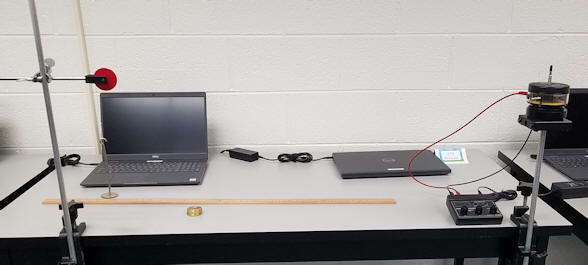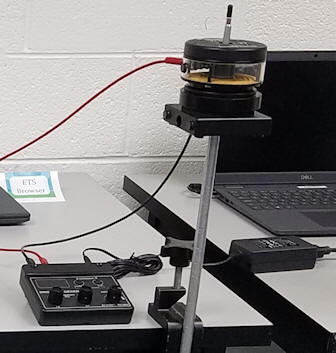Mechanical Waves
A wave pulse is a disturbance that moves through a medium. A
periodic wave is a periodic
disturbance that moves through a medium. The medium itself goes nowhere.
The individual atoms and molecules in the medium oscillate about their
equilibrium position, but their average position does not change. If the
displacement of the individual atoms or molecules is perpendicular to the
direction the wave is traveling, the wave is called a transverse wave. If the displacement is parallel to the
direction of travel the wave is called a longitudinal wave or a
compression wave.
Waves can transport energy and information. Examples of mechanical
waves are water waves, sound waves, and seismic waves. All waves are described
mathematically in terms of a wave function, and reflection,
refraction and diffraction and
interference a characteristic behaviors of all types of waves.
In this session you will study wave motion in one dimension only, to learn
about several of these characteristic behaviors. You will study the motion of
waves on a string.
Equipment needed:
- wave driver
- sine wave generator
- pulley
- base and support rods and clamps
- mass hanger and masses
- level
- meter stick
Open a Microsoft Word document to keep a log of your
experimental procedures, results and discussions. Address the points highlighted in blue. Answer all
questions.
Exploration
Use an on-line simulation from the University of Colorado PhET
group to explore the behavior of waves on a string.
Link to the simulation:
http://phet.colorado.edu/en/simulations/wave-on-a-string
(a) Explore the interface. Try the different controls.
(b) Investigate the behavior of a wave pulse.
- Start with the following settings:
- Pulse
- No End
- Amplitude: 0.5 cm
- Pulse Width: 0.5 s
- Damping: none
- Tension: high
- Ruler and timer: checked
- Observe this pulse and measure its speed in cm/s.
(You can start and stop the pulse and use slow motion.)
- Vary (one at a time) amplitude, pulse width, damping, and tension, and
describe what happens.
- Return to the original pulse but change the end first to a loose end and then
to a fixed end and describe what happens.
(c) Investigate the behavior of a traveling wave.
- Start with the following settings:
- Oscillate
- No End
- Amplitude: 0.5 cm
- Frequency: 1.5 Hz
- Damping: none
- Tension: high
- Ruler and timer: checked
- Observe this wave (wave 1) and make measurements. Enter your measurements into the table.
- Measure the amplitude of the wave in cm.
- Measure the wavelength in cm.
- Measure the period in s.
- Find the speed of the wave in cm/s.
| |
wave 1 |
wave 2 |
wave 3 |
wave 4 |
wave 5 |
| amplitude A |
|
|
|
|
|
| wavelength λ |
|
|
|
|
|
| period T |
|
|
|
|
|
| frequency f |
|
|
|
|
|
| speed v |
|
|
|
|
|
- Move the amplitude slider to 0.25 cm (wave 2)
and then to 0.75 cm (wave 3).
Make new measurements. Describe what changes.
- With the amplitude slider at 0.5 cm, move the frequency slider to 1 Hz (wave 4) and then to
2 Hz (wave 5).
Make new measurements. Describe what
changes.
- Discuss the relationships between wavelength and frequency, period and
frequency, amplitude and frequency and speed and frequency.
- Can you change the speed of the wave? What can you do to produce a
wave that moves with approximately 1/4 the speed of wave 1.
- Describe what happens when you include damping.
(d) Investigate the behavior of a standing wave.
- Start with the following settings:
- Oscillate
- No End
- Amplitude: 0.5 cm
- Frequency: 0.75Hz
- Damping: 1 notch
- Tension: high
- Ruler and timer: checked
- Describe the wave. What is its maximum amplitude in cm? Does
this maximum amplitude change when you change the frequency slider?
- Change the end to a fixed end.
- Slowly increase the frequency.
Wait several seconds to see what happens to the maximum displacement
from equilibrium of the wave for each frequency setting.
- For which frequencies between 0.75 Hz and 1.7 Hz is the maximum displacement from equilibrium
largest (larger than that of the traveling wave)? In other
words, for which frequencies do you hit resonance? What happens if you set
the damping to zero at those frequencies?
- What can you say about the wavelengths associated with those frequencies?
Experiment
Standing waves of many different wavelengths can be produced on a
string with two fixed ends, as long as an integral number of half wavelengths
fit into the length of the string. For a standing wave on a string of length L
with two fixed ends
L = n(λ/2), n = 1,2,3,... .
- Fundamental: L = λ/2, n = 1, 1/2 wavelength fits into the length of the string.
- Second harmonic: L = λ n = 2, one wavelength fits into the length of the string.
- Third harmonic: L = 3λ/2, n = 3, 3/2 wavelengths fit into the length of the string.
For a string the speed of the waves is a function of the mass per unit length
μ = m/L of the string and the tension F in the string.
v = √(F/μ).
In this lab, waves on a string with two fixed ends will be generated by a
the Pasco Mechanical Wave Driver connected to a Sine Wave Generator.
You can vary the frequency of the waves. Their wavelength
is given by λ = v/f. The speed of
the waves can be changed by changing the string tension. For two different
tensions, you will adjust the
frequency f of the sine wave generator until 1, 2, 3 or 4 half wavelength of a wave fit into the length of the string. Then
f is a natural frequency of the
string and the generator drives the string into resonance. The amplitude
increases and the standing waves can easily be observed.
Summary:
Choose the tension F.
Measure the frequency f, for λ = 2L, L, 2L/3, L/2.
Calculate the mass per unit length μ of the string,
using v = λf, μ = F/v2.
Procedure:
-
Mount the wave driver on a rod which is fixed to the table with a clamp.
Mount the pulley onto another rod fixed to the table with a clamp. Pass a
string from the vibrator over the pulley and attach a mass hanger. Let the
length of the string from the wave generator to the top of the pulley be
approximately 1 m. Make
sure the string is level. (Use a level or your phone.) You now have a string with two fixed ends.



Note:
Before you mount the Vibration Generator on the rod and attach the string, make
sure that the lock is in the "lock" position.

Plug in the sine wave generator and connect it to the vibration
generator.
After you have competed your setup, move the lock lever to the "Unlock"
position.
- The amplitude of the wave driver is so small compared to the
amplitude of the string at resonance, so that the wave driver is very close to a node.
- Open an Excel spreadsheet and paste the table below into the spreadsheet.
|
n |
hanging
mass
(kg) |
tension
F = mg (N) |
measured L (m) |
f
(Hz = s-1) |
λn = 2L/n
(m) |
speed
vn = fλn
(m/s) |
mass/length
μ = F/v2 |
Fundamental:
(n = 1) |
1 |
0.15 |
|
|
|
|
|
|
Second harmonic
(n = 2) |
2 |
0.15 |
|
|
|
|
|
|
Third Harmonic:
(n = 3) |
3 |
0.15 |
|
|
|
|
|
|
Fourth Harmonic:
(n = 4) |
4 |
0.15 |
|
|
|
|
|
|
Fundamental:
(n = 1) |
1 |
0.2 |
|
|
|
|
|
|
Second harmonic
(n = 2) |
2 |
0.2 |
|
|
|
|
|
|
Third Harmonic:
(n = 3) |
3 |
0.2 |
|
|
|
|
|
|
Fourth Harmonic:
(n = 4) |
4 |
0.2 |
|
|
|
|
|
|
- The mass hanger's mass is 50 g. Add a 100 g mass to the hanger,
calculate the tension F = mg and enter this value into the spreadsheet. (g
= 9.8 m/s2)
- Let the length of the string from the wave generator to the top of the
pulley be approximately 1 m. Enter the measured length L into
the appropriate cells of the spreadsheet.
- For your chosen length L use the spreadsheet to calculate the wavelength λn
= 2L/n and then the speed vn= fλn = 2fL/n of the fundamental and second and third
harmonic for f = 120 Hz.
- Turn on wave driver with maximum amplitude and adjust the frequency f. Try to produce the fundamental standing wave on the string.
Use the fine-adjust knob of the frequency generator and near resonance vary the
frequency very slowly until you observe a stable resonance. Enter the value
of f into the spreadsheets.
- Repeat for the second and third and fourth harmonic and fill in the table.
- Repeat the whole procedure for a 150 g mass added to the mass hanger.
Data Analysis:
Calculate the mass per unit length μ of the string using μ
= F/v2. Average the values obtained from your eight measurements
and estimate the uncertainty in this average value.
Discuss:
- Were you able to clearly identify the resonances?
- How do your values of μ obtained from the eight measurements compare? In your opinion, are they equal within
experimental uncertainties. If not, what do you think can explain the differences?
Convert your log into a lab report.
Name:
E-mail address:
Laboratory 11 Report
- In one or two sentences, state the goal of this lab.
- Make sure you completed the entire lab and answered all parts. Make
sure you show your work and inserted and properly labeled relevant tables
and plots.
- Add a reflection at the end of your report in a short essay format.
Save your Word document (your name_lab11.docx), go to Canvas, Assignments, Lab
11, and submit your document.



